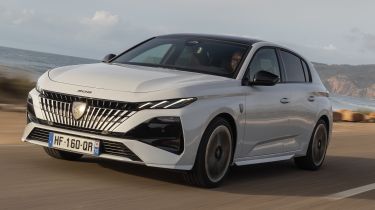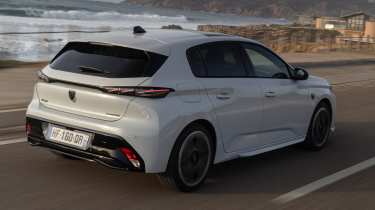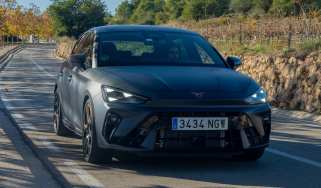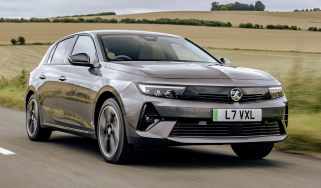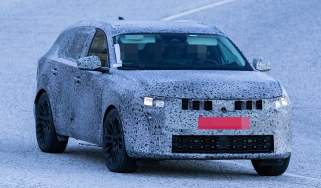New Peugeot 308 Hybrid 2026 review: latest facelift sharpens the French hatchbacks appeal
New looks and bigger batteries for the updated Peugeot 308 range, but the regular Hybrid is the one to go for.

Verdict
Peugeot has given its handsome 308 family a little bit of spit-and-polish, predominantly centred on a notable visual facelift at the front, but also including larger batteries for the plug-in hybrid and fully electric E-308 models for greater zero-emission driving range. However, it’s the largely unchanged Hybrid model which wins our vote, as it’s a classy and likeable operator.
Peugeot still has faith in the traditional C-segment compact family hatch and estate, despite the fact they have been under showroom attack from SUVs, and so the French firm has high hopes for its revised 308 line-up.
Still proving itself a strong seller across Europe, the third-generation 308 arrived in 2022 and has now been given a mid-life facelift.
The easiest way to spot the new 308 is via the dramatic new radiator grille and headlight arrangement, which does away with the old ‘slash’ running lights that used to run down the outer edges of the Peugeot’s front end.
Instead, there are neater ‘triple-claw’ lamp units, and even a full-width illuminated band centred on the company’s first-ever light-up badge – which, in a bit of aesthetic trickery, hides the radar needed for various advanced driver assistance systems (ADAS) on the 308.
Used - available now
However, if you want the fancy new light pattern on your 308, it’s only standard on the GT and GT Premium specification cars. Basic Allure versions do without.
Beyond that, the exterior changes are restricted to a couple of new body colours – they’re both blues, called Lagoa and Ingaro, although the latter has a strong green element – and some fresh alloy wheel designs.
Inside, nothing has been significantly altered, although the 3D graphics in the configurable 10-inch driver’s cluster are sharpened up.
This is not bad news, though, because the 308’s interior is a nicely put together effort, with interesting design and effective use of premium-feeling materials. The ‘AGR’ front seats are also worth singling out for praise (AGR stands for Aktion für Gesunder Rücken, and means they are approved by German ergonomics experts).
That said, it’s all still focused on Peugeot’s i-Cockpit arrangement of a small, low-set steering wheel and high-mounted instrument cluster. As we’ve said many times before, not everyone gets on with this layout, as some drivers can find various details in the cluster are blocked by the wheel’s rim.
Furthermore, despite the presence of five ‘i-Toggle’ configurable digital shortcut buttons underneath the central infotainment screen, there’s still too much tapping about on the dash display itself to operate various functions. Things like the heated seats and the heated steering wheel are more complex to operate than they strictly should be.
As ever with the 308, passenger space in the rear is adequate but not exceptional. Taller occupants might find that they’re a little lacking for legroom and headroom, but it’s generally acceptable back there for people of average height.
Boot space in the Hybrid hatch is a competitive 412 litres, although in the new Plug-In Hybrid model that figure drops significantly to 314 litres. The E-308 sits roughly in the middle, with 361 litres of capacity.
For those wanting more luggage space, the elegant and handsome 308 SW estate continues, accommodating between 467 litres (for the PHEV) and 599 litres (Hybrid).
Technically speaking, the major news for the updated 308 comes with both the PHEV and electric models. Both of these receive larger battery packs for greater driving range, with the E-308 officially now capable of up to 281 miles in one hit – an increase of 23 miles from its previous incarnation, thanks to a battery now rated at a usable capacity of 55.4kWh.
You might therefore think the poor old Hybrid, ostensibly sitting at the bottom of the drivetrain pile, is the weak link. But we’d disagree. In fact, we think it is the sweetest of all the new 308s to drive, because its 1.2-litre powertrain is the most charismatic of the lot, while it has a significant weight advantage over its electrically enhanced stablemates.
This makes the Hybrid the most agile 308 in the range by some distance in corners, ably assisted by a natural-feeling steering set-up that lacks the heavy weighting and artificiality of Sport mode in the E-308.
A Hybrid 308 is not out-and-out fun in bends, but it’s the model keener drivers will be happiest to hustle when the right road presents itself.
Yet it’s also the comfiest, although every 308 in the range is plush and refined to travel in. However, we did a long, high-speed motorway run in the Hybrid and it was a delight in such conditions – planted, stable, suitably hushed and strong enough in the mid-range to make light work of regaining speed lost behind overtaking HGVs.
It even delivered 42mpg with sustained running at 75mph – a testament to its modest degree of electrical assistance.
If there’s any minor blemish on the dynamics, it comes with the ‘e-DSC6’ dual-clutch gearbox. It’s fine, but it tends to hesitate when making shifts on about half-throttle. Otherwise, it’s a reasonably slick unit.
Nevertheless, with the revised 308, we think less is more. All versions have their merits, but it’s the Hybrid we’d recommend as the top choice.
| Model: | Peugeot 308 Hybrid GT Premium |
| Price: | £33,395 as tested |
| Powertrain: | 1.2-litre 3-cyl petrol hybrid |
| Power/torque: | 145bhp/230Nm |
| Transmission: | Six-speed dual-clutch auto, front-wheel drive |
| 0-62mph: | 8.8 seconds |
| Top speed: | 130mph |
| Economy: | 48.5-62.6mpg |
| CO2: | 102-131g/km |
| Size (L/W/H): | 4,367/1,852/1,454mm |
| On sale: | Now |
Did you know you can sell your car through Auto Express? We’ll help you get a great price and find a great deal on a new car, too.

